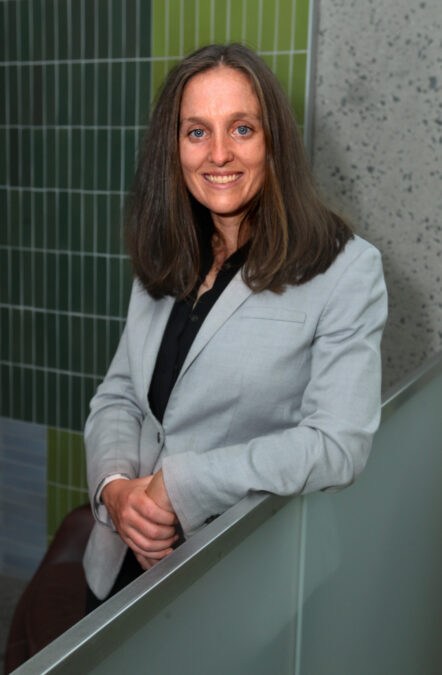By Molly A. Seltzer

Kelsey Hatzell made a career of seeing things that could not be seen. When she saw potential in nascent battery technology, one that could not be studied because of its opaque nature, she developed novel imaging techniques to see the hidden interface between the energy-carrying electrons and energy-generating electrodes. With it, she uncovered the ability of solid-state batteries to help store renewable energy power and reduce global emissions.
“I was intentionally going in a direction that was less studied because the physics and chemistry were fascinating,” said Hatzell, who joined Princeton as an assistant professor of mechanical and aerospace engineering and the Andlinger Center for Energy and the Environment as of July 1, 2021.
What distinguishes solid-state batteries from other types of batteries is how they move ions and their interfaces. Typically, a liquid electrolyte or electrolyte solution allows ions to move between electrodes, the negative and positive ends of a battery, generating an electric charge. Traditional batteries, like lithium-ion batteries, use this liquid or a gel-like electrolyte, creating a solid|liquid interface between the electrode and the electrolyte, which can be probed by scientists. But solid-state ones, as the name suggests, use a solid electrolyte to facilitate ion movement, creating a solid|solid interface. The interface has become known as a “buried interface,” because scientists could not see into it and few understood how to study it.
“It’s like trying to look underground to see what’s happening,” Hatzell said.
After completing her Ph.D. in material science and engineering at Drexel University, Hatzell built the Inks and Interfaces research group at Vanderbilt University to explore these rich scientific questions of how to first access the buried interface and then study it. Her group worked on characterization techniques and spatial mapping to understand mass transport and how ions move in real time. She wanted to test batteries before they died to understand ion movement as it occurs.
Over the last several years, Hatzell has conducted the research that underpins most of what the world knows about solid-state batteries today. She is at the cutting edge of synchrotron x-ray tomography, a type of imaging approach that uses x-rays and a scanning system to visualize materials and material systems in three dimensions.
“When I went into solid-state batteries, I thought it was an area that I could make a contribution towards. I had worked on developing advanced characterization technologies that can look into batteries,” said Hatzell.
Solid-state batteries have since gained in popularity, and are being explored by large companies because they are not flammable and can use energy-dense anode materials that are incompatible with conventional lithium-ion batteries. Hatzell’s group has worked collaboratively with automotive companies to examine new materials and materials design strategies for next-generation solid-state batteries.
“And five years later, we’ve unequivocally proven that accessing buried interfaces is no longer a question. We know how to get to these interfaces,” said Hatzell.
With that black box successfully opened, she is broadening her work at Princeton to study interfaces beyond batteries and energy storage systems. According to Hatzell, there is a lot to be learned at the fundamental level from these systems. Her lab members are looking at one emerging area of study: how water organizes at heterogeneous interfaces. They are studying how electric fields affect ions, molecules, and water. She said understanding how ions and molecules move through interfaces, as she studied with batteries, has broad impacts. This knowledge could help in efforts to electrify industrial processes and develop separations processes for water treatment, desalination, carbon dioxide sequestration and utilization, and other key separations applications.
Hatzell was recognized in 2019 with an NSF CAREER award, in 2020 as an Alfred P. Sloan Research Fellow in Chemistry, and most recently, in 2021, with the POLiS Award of Excellence for Female Researchers from the German Battery Research Consortium. She also earned the ECS Toyota Young Investigator Award in 2019, among other accolades. Hatzell’s research has been published in Joule, ACS Applied Materials and Interfaces, Environmental Science & Technology, Journal of the American Chemical Society, Environmental Science & Technology Letters, and others.